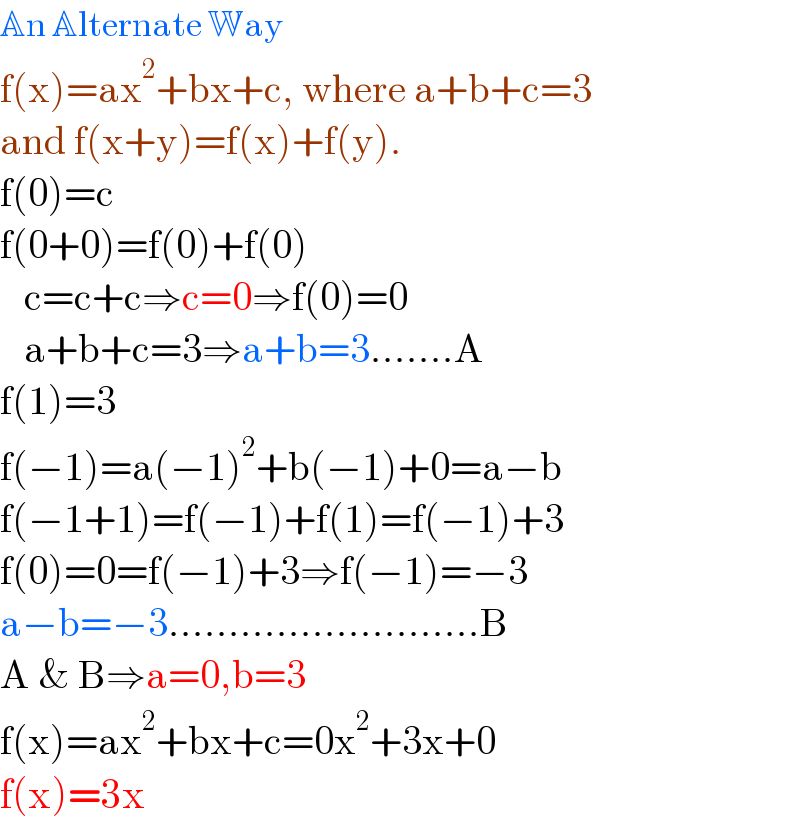Question Number 155500 by VIDDD last updated on 01/Oct/21

Answered by MJS_new last updated on 01/Oct/21

$${f}\left({x}+{y}\right)−\left({f}\left({x}\right)+{f}\left({y}\right)\right)=\mathrm{0} \\ $$$$\mathrm{2}{axy}−{c}=\mathrm{0} \\ $$$$\mathrm{this}\:\mathrm{is}\:\mathrm{only}\:\mathrm{true}\:\forall{x},{y}\in\mathbb{R}\:\mathrm{with}\:{a}=\mathrm{0}\:\Rightarrow\:{c}=\mathrm{0} \\ $$$${a}+{b}+{c}=\mathrm{3}\:\Rightarrow\:{b}=\mathrm{3} \\ $$$${f}\left({x}\right)=\mathrm{3}{x} \\ $$$$\mathrm{the}\:\mathrm{rest}\:\mathrm{is}\:\mathrm{easy} \\ $$
Commented by VIDDD last updated on 01/Oct/21

$${greay}\:{sir}\:;\:{thanks} \\ $$
Commented by puissant last updated on 01/Oct/21

$${f}\left({n}\right)=\mathrm{3}{n} \\ $$$$\Rightarrow\:\underset{{n}=\mathrm{1}} {\overset{\mathrm{10}} {\sum}}{f}\left({n}\right)=\underset{{n}=\mathrm{1}} {\overset{\mathrm{10}} {\sum}}\mathrm{3}{n}=\mathrm{3}\underset{{n}=\mathrm{1}} {\overset{\mathrm{10}} {\sum}}{n}=\mathrm{3}\bullet\frac{\mathrm{10}×\mathrm{11}}{\mathrm{2}} \\ $$$$=\mathrm{3}×\mathrm{55}=\:\mathrm{165}… \\ $$
Answered by Rasheed.Sindhi last updated on 02/Oct/21

$$\mathbb{A}\mathrm{n}\:\mathbb{A}\mathrm{lternate}\:\mathbb{W}\mathrm{ay} \\ $$$$\mathrm{f}\left(\mathrm{x}\right)=\mathrm{ax}^{\mathrm{2}} +\mathrm{bx}+\mathrm{c},\:\mathrm{where}\:\mathrm{a}+\mathrm{b}+\mathrm{c}=\mathrm{3} \\ $$$$\mathrm{and}\:\mathrm{f}\left(\mathrm{x}+\mathrm{y}\right)=\mathrm{f}\left(\mathrm{x}\right)+\mathrm{f}\left(\mathrm{y}\right). \\ $$$$\mathrm{f}\left(\mathrm{0}\right)=\mathrm{c} \\ $$$$\mathrm{f}\left(\mathrm{0}+\mathrm{0}\right)=\mathrm{f}\left(\mathrm{0}\right)+\mathrm{f}\left(\mathrm{0}\right) \\ $$$$\:\:\:\mathrm{c}=\mathrm{c}+\mathrm{c}\Rightarrow\mathrm{c}=\mathrm{0}\Rightarrow\mathrm{f}\left(\mathrm{0}\right)=\mathrm{0} \\ $$$$\:\:\:\mathrm{a}+\mathrm{b}+\mathrm{c}=\mathrm{3}\Rightarrow\mathrm{a}+\mathrm{b}=\mathrm{3}…….\mathrm{A} \\ $$$$\mathrm{f}\left(\mathrm{1}\right)=\mathrm{3} \\ $$$$\mathrm{f}\left(−\mathrm{1}\right)=\mathrm{a}\left(−\mathrm{1}\right)^{\mathrm{2}} +\mathrm{b}\left(−\mathrm{1}\right)+\mathrm{0}=\mathrm{a}−\mathrm{b} \\ $$$$\mathrm{f}\left(−\mathrm{1}+\mathrm{1}\right)=\mathrm{f}\left(−\mathrm{1}\right)+\mathrm{f}\left(\mathrm{1}\right)=\mathrm{f}\left(−\mathrm{1}\right)+\mathrm{3} \\ $$$$\mathrm{f}\left(\mathrm{0}\right)=\mathrm{0}=\mathrm{f}\left(−\mathrm{1}\right)+\mathrm{3}\Rightarrow\mathrm{f}\left(−\mathrm{1}\right)=−\mathrm{3} \\ $$$$\mathrm{a}−\mathrm{b}=−\mathrm{3}……………………..\mathrm{B} \\ $$$$\mathrm{A}\:\&\:\mathrm{B}\Rightarrow\mathrm{a}=\mathrm{0},\mathrm{b}=\mathrm{3} \\ $$$$\mathrm{f}\left(\mathrm{x}\right)=\mathrm{ax}^{\mathrm{2}} +\mathrm{bx}+\mathrm{c}=\mathrm{0x}^{\mathrm{2}} +\mathrm{3x}+\mathrm{0} \\ $$$$\mathrm{f}\left(\mathrm{x}\right)=\mathrm{3x} \\ $$
